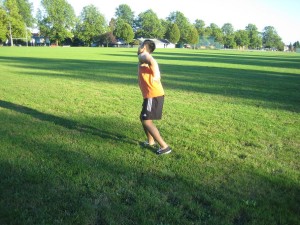Spondylolisthesis is basically a back injury that involves the forward slippage of a vertebra over another. This is typically seen in children between the ages of 9-14 years old.
Symptoms
The symptoms of spondylolisthesis can be categorized as grade 1-4 depending on the degree of severity. When it comes to a grade 1 injury, there are no symptoms at all and the individual is unaware that they have a defect in the spine.
For grade 2 spondylolisthesis, the symptoms typically include low back pain that may or may not radiate into the legs. The pain is aggravated by certain activities that involve backwards bending of the spine. It is also possible that the individual will feel a dip in the spine at the area where the vertebrae slips forward. In most cases, an X-ray taken in a position that triggers the pain can confirm a diagnosis. To learn to recognize and manage back injuries, sign up for a first aid class today.

Close look on spondylolisthesis
Spondylolisthesis is known to occur in sports that involve a lot of strain on the back, particularly in wrestling, gymnastics and weight lifting. The risk of forward slippage in individuals over 21 years old is small. It is usually the fifth or bottom lumbar vertebra that is involved by slipping forward over the S1.
The condition is often seen along with a stress fracture of defect of the pars interarticularis. Cases of pars interarticularis issues that are linked with spondylolysis are those who had history of the problem. The stress fractures of pars interarticularis via overuse are thought to be rarely the cause of spondylolisthesis.
It is important to note that spondylolisthesis can be graded depending on how far the vertebra has slipped which is measured by an X-ray from the side:
- Grade 1 – 25% forward movement
- Grade 2 – greater than 25% forward movement
- Grade 3 – higher than 50% forward movement
- Grade 4 – higher than 75% forward movement
Treatment of spondylolisthesis
- The individual should rest from activities that cause or worsen the pain
- The individual might be able to continue training but avoid exercises that will strain on the back
- The hamstring muscles must be stretched since tight muscles can rotate the pelvis in a backwards manner in relation to the forward slipping vertebra.
- The individual should perform abdominal as well as core strengthening exercises
- A back support or brace should be used to prevent the lower spine from bending forward excessively
If possible, it is best to consult a sports injury professional for proper assessment of the condition.
When a doctor is consulted
The doctor will prescribe strengthening exercises. In most cases, the doctor will mobilize the joints in a gentle manner around the forward slipping joint. Just remember though that manipulation must not be done at the joint itself. If other treatment options are not successful, it would require surgery.
Returning to sports
For cases involving grade 1 and 2 injuries, the individual can return as soon as he/she is free from pain and has good core strength.
Those who have grade 3 and 4 injuries must avoid contact sports or those that involve high speed and changes in direction.
It is important to note that spondylolisthesis does not actually worsen, but if the amount of slipping increases, a doctor might perform surgery to fuse the bones together in order to prevent further forward slipping.
